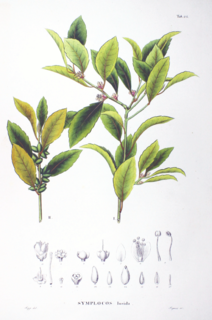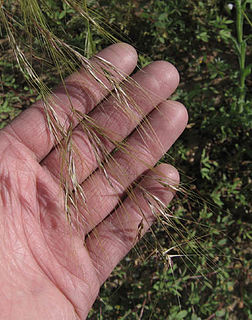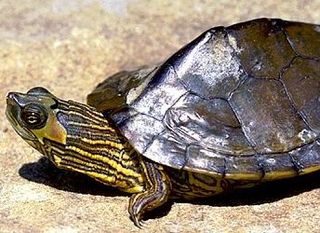
Symplocos is a genus of flowering plants in the order Ericales. It contains about 300 species distributed in Asia and the Americas. Many species grow in humid tropical regions. This is sometimes considered to be the only genus in family Symplocaceae. Plants in this family are shrubs and trees with white or yellow flowers.

Nassella pulchra, basionym Stipa pulchra, is a species of grass known by the common names purple needlegrass and purple tussockgrass. It is native to the U.S. state of California, where it occurs throughout the coastal hills, valleys, and mountain ranges, as well as the Sacramento Valley and parts of the Sierra Nevada foothills, and Baja California.

The beautiful jay is a species of bird in the crow and jay family Corvidae. It is closely related to the azure-hooded jay, and the two species are considered sister species. The species is monotypic, having no subspecies. The specific name for the beautiful jay, pulchra, is derived from the Latin word for beautiful.
Symplocos anamallayana is a species of plant in the family Symplocaceae. It is endemic to India.
Symplocos bractealis is a species of plant in the family Symplocaceae. It is endemic to Sri Lanka.
Symplocos canescens is a species of plant in the family Symplocaceae. It is endemic to Ecuador. Its natural habitat is subtropical or tropical moist montane forest.
Symplocos cordifolia is a species of plant in the family Symplocaceae. It is endemic to Sri Lanka.
Symplocos costata is a species of plant in the family Symplocaceae. It is endemic to Sumatra. It is a vulnerable species threatened by habitat loss.
Symplocos fuscata is a species of plant in the family Symplocaceae. It is endemic to Ecuador. Its natural habitat is subtropical or tropical moist montane forest.
Symplocos molinae is a species of plant in the family Symplocaceae. It is endemic to Honduras.
Symplocos octopetala is a species of evergreen woody plant with small white flowers in the family Symplocaceae. It is endemic to Jamaica. First described in 1788, the most recent concept of the species includes three taxa described as separate species in the late 19th and early 20th century.
Symplocos oligandra is a species of plant in the family Symplocaceae. It is endemic to India. It is threatened by habitat loss.
Symplocos peruviana is a species of plant in the family Symplocaceae. It is endemic to Peru.

The montane monkey-faced bat is a megabat endemic to the Solomon Islands. It is listed as a critically endangered species. Due to its imperiled status, it is identified by the Alliance for Zero Extinction as a species in danger of imminent extinction. In 2013, Bat Conservation International listed this species as one of the 35 species of its worldwide priority list of conservation. Only one individual has ever been found.

Symplocaceae is a family of flowering plants in the order Ericales, including two genera, Symplocos and Cordyloblaste, totalling about 260 known species. The common name for Symplocaceae is sweetleaf. Symplocaceae has a transpacific distribution that covers the Southeast United States, South America, Southeast Asia and Northern Australia. Plants in the family Symplocaceae are generally trees or shrubs, and are found in humid, tropical, montane forests within their range.

The Alabama map turtle is a species of emydid turtle endemic to the southern United States. Differentiation from other turtle species includes a black stripe running down the center of its back with knobs extruding from it, but these projections wear down with age. T.H. Bean and L. Kumlen first collected the Alabama map turtle in July 1876 from a lake near Montgomery, Alabama. Type locality for this species is Montgomery County, Alabama. Baur described and named the Alabama map turtle in 1893. The genus Graptemys includes nine species of mostly aquatic turtles.

Symplocos tinctoria is a deciduous or evergreen shrub or tree. It is recognized by pith of twigs chambered; by foliage not notably aromatic when bruised, leaves finely hairy beneath. Shrubs or trees to 17 m tall by 36 cm DBH. The largest first-year twigs are under 3 mm across, terminal buds with acute tip, scales ciliate. Leaves are 7–15 cm long, margin entire or occasionally some teeth on the apical half, with a sweet taste that may be faint in old leaves. It is conspicuous when in flower; flowers opening before new leaves develop, fragrant, in clusters from axils of previous year's leaves or from just above the leaf scars if the leaves have fallen; the petals are creamy yellow to yellow, with one pistil. Fruits nearly cylindrical to ellipsoid drupes 8–12 mm long, with thin pulp and a hard stone containing 1 seed; the tip usually retaining parts of the sepals. Foliage is relished by browsing wildlife. A yellow dye may be obtained from bark and leaves. It flowers Mar to May.

Nepenthes pulchra is a tropical pitcher plant endemic to the Philippine island of Mindanao, where it grows at 1300–1800 m above sea level. Its discovery was announced online in August 2011.
Symplocos coronata is a species of plant in the family Symplocaceae. It is endemic to Sri Lanka.







